Abstract
Heijunka is a key-element of the Toyota production system which levels the release of production kanbans in order to achieve an even production flow over all possible types of products, thus, e.g. reducing the bullwhip effect. In this paper we analyze a kanban controlled and heijunka leveled production system where the arriving demands are controlled and limited by a kanban loop. The production system is modeled as a queueing network with synchronization stations. The aim is to determine the optimal number of production kanbans, and thus the buffer size that guarantees a given service level.
Similar content being viewed by others
References
Akturk M. S., Erhun F. (1999) An overview of design and operational issues of kanban systems. International Journal of Production Research 37(17): 3859–3881
Bard J. F., Golany B. (1991) Determining the number of kanbans in a multiproduct, multistage production system. International Journal of Production Research 29(5): 881–895
Berkley B. J. (1992) A review of the kanban production control research literature. Production and Operations Management 1(4): 393–411
Bitran G. R., Chang L. (1987) A mathematical programming approach to a deterministic kanban system. Management Science 33(4): 427–441
Bollon J. M., Di Mascolo M., Frein Y. (2004) Unified framework for describing and comparing the dynamics of pull control policies. Annals of Operation Research, Special Issue on Stochastic Models of Production-Inventory Systems 125: 21–45
Bonvik, A. M. (1996). Performance analysis of manufacturing systems under hybrid control policies. PhD thesis, Massachusetts Institute of Technology.
Buzacott J. A. (1989) Queueing models of kanban and MRP controlled manufacturing systems. Engineering Cost and Production Economics 17: 3–20
Coleman, B. J., & Vaghefi, M. R. (1994). Heijunka (?): A key to the Toyota production system. Production and Inventory Management Journal, 31–35.
Dallery Y., Liberopoulos G. (2000) Extended kanban control system: Combining kanban and base stock. IIE Transactions on Design and Manufacturing 32: 369–386
Davis W. J., Stubitz S. J. (1987) Configuring a kanban system using a discrete optimization of multiple stochastic responses. International Journal of Production Research 25(5): 721–740
De Araujo, S. L., Frein, Y., & Di Mascolo, M. (1995). Efficient procedures for the design of kanban systems. International Conference on Industrial Engineering and Production Management, Marrakech, 511–520
De Smet R., Gelders L. (1997) Evaluation of the role of waste in a truck manufacturing line using simulation. Journal of Intelligent Manufacturing 8(5): 449–458
Di Mascolo M., Frein Y., Dallery Y. (1996) An analytical method for performance evaluation of kanban controlled production systems. Operations Research 44(1): 50–64
Di Mascolo M. (1996) Analysis of a synchronization station for the performance evaluation of a kanban system with a general arrival process of demands. European Journal of Operational Research 89(1): 147–163
Duri C., Frein Y., Di Mascolo M. (2000) Comparison among three pull control policies: Kanban, base stock, and generalized kanban. Annals of Operations Research 93: 41–69
Framinan J. M., Gonzalez P. L., Ruiz-Usano R. (2003) The CONWIP production control system: Review and research issues. Production Planning and Control 14(3): 255–265
Furmans K. (2005) Models of heijunka-levelled kanban-systems. 5th International conference on analysis of manufacturing systems—Production management, Zakynthos Island, Greece.
Gaury E. G. A., Pierreval H., Kleijnen P. C. (2000) An evolutionary approach to select a pull system among kanban, conwip and hybrid. Journal of Intelligent Manufacturing 11: 157–167
Huang C. C., Kusiak A. (1996) Overview of kanban systems. International Journal of Computer Integrated Manufacturing 9: 169–189
Ip W. H., Huang M., Ying K. L., Wang D., Wang X. (2007) CONWIP based control of a lamp assembly production line. Journal of Intelligent Manufacturing 18: 261–271
Kimura O., Terada H. (1981) Design and analysis of pull system: A method of multistage production control. International Journal of Production Research 19: 241–253
Khojasteh-Ghamari, Y. (2008). A performance comparison between Kanban and CONWIP controlled assembly systems. Journal of Intelligent Manufacturing. Published online Sept 2008. doi:10.1007/s10845-008-0174-5.
Liker J. K. (2004) The Toyota way, 14 management principles from the worlds greatest manufacturer, 1st edn. McGraw-Hill, New York
Lippolt C. R., Furmans K. (2008) Sizing of heijunka-controlled production systems with unreliable production processes, in IFIP international federation for information processing. Lean Business Systems and Beyond 257: 11–19
Monden Y. (1981) Adaptable kanban system helps Toyota maintain just-in-time production. Industrial Engineering 13(5): 29–46
Monden Y. (1998) Toyota production system: An integrated approach to just-in-time, 3rd edn. Engineering and Management Press, Norcross, Georgia
Ohno T. (1988) Toyota production system: Beyond large-scale production. Productivity Press, Cambridge, Massachusetts
Paris J. L., Pierreval H. (2001) A distributed evolutionary simulation optimisation approach for the configuration of multiproduct kanban systems. International Journal of Computer Integrated Manufacturing 14: 421–430
Rother M., Shook J. (2003) Learning to see. Lean Enterprise Institute, Cambridge, Massachusetts
Schonberger R. J. (1982a) The transfer of Japanese manufacturing management approaches to US industry. Academy of Management Review 7(3): 479–487
Schonberger R. J. (1982b) Japanese manufacturing techniques: Nine hidden lessons in simplicity. The Free Press, New York
Sendil Kumar C., Panneerselvam R. (2007) Literature review of JIT-KANBAN system. The International Journal of Advanced Manufacturing Technology 32(3–4): 393–408
Shahabudeen P., Krishnaiah K., Thulasi Narayanan M. (2003) Design of a two-card dynamic kanban system using a simulated annealing algorithm. International Journal of Advanced Manufacturing Technology 21(10–11): 754–759
Spearman M., Woodruff D., Hopp W. (1990) CONWIP: A pull alternative to kanban. International Journal of Production Research 28: 879–894
Wang H., Wang H. P. (1990) Determining the number of kanbans: A step toward non-stock-production. International Journal of Production Research 28(11): 2101–2115
Wang H., Wang H. P. (1991) Optimum number of kanbans between two adjacent workstations in a JIT system. International Journal of Production Economics 22(3): 179–188
Wang S., Sarker B. R. (2006) Optimal models for a multi-stage supply chain system controlled by kanban under just-in-time philosophy. European Journal of Operations Research 172(1): 179–200
Author information
Authors and Affiliations
Corresponding author
Rights and permissions
About this article
Cite this article
Matzka, J., Di Mascolo, M. & Furmans, K. Buffer sizing of a Heijunka Kanban system. J Intell Manuf 23, 49–60 (2012). https://doi.org/10.1007/s10845-009-0317-3
Received:
Accepted:
Published:
Issue Date:
DOI: https://doi.org/10.1007/s10845-009-0317-3




